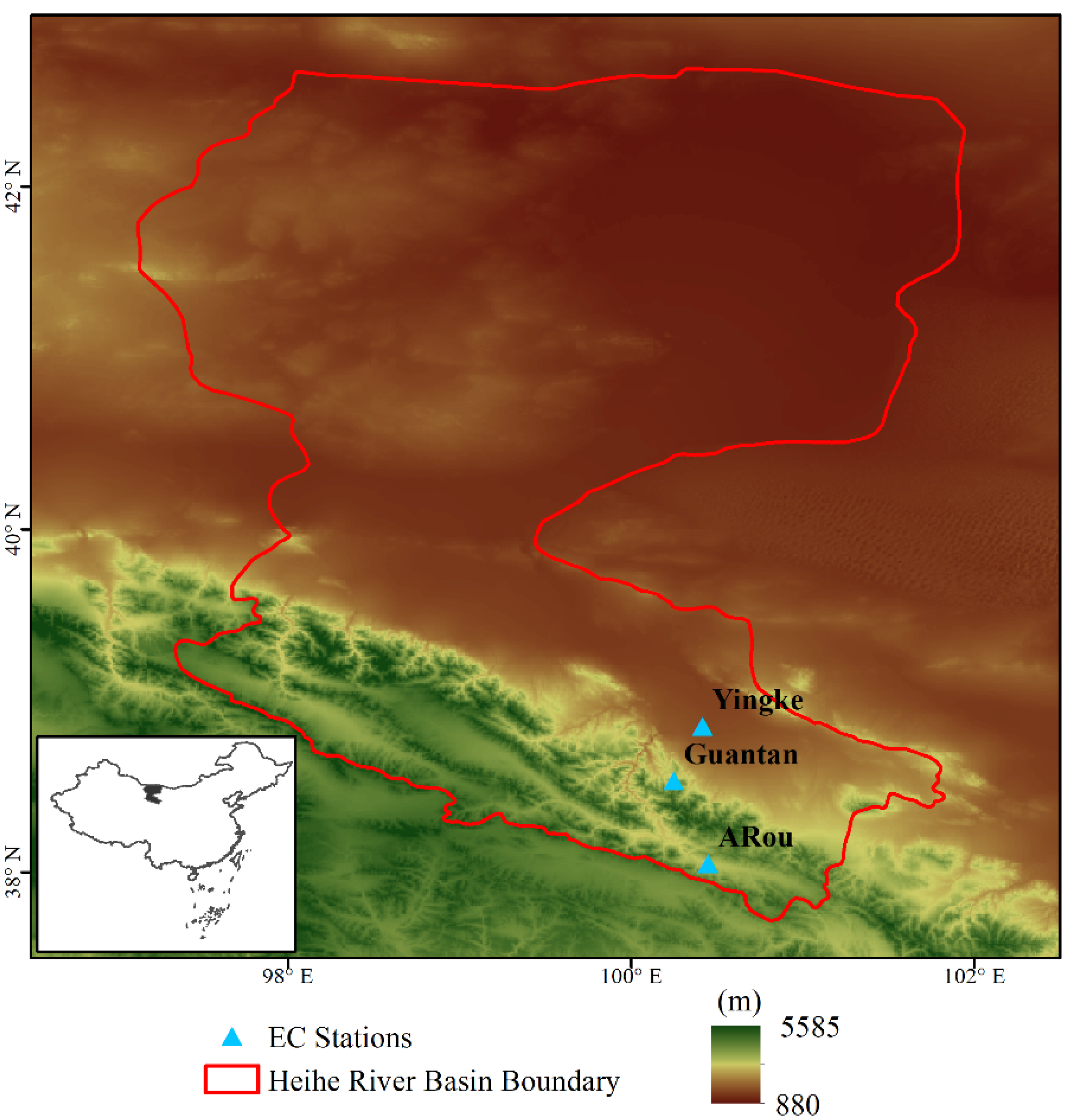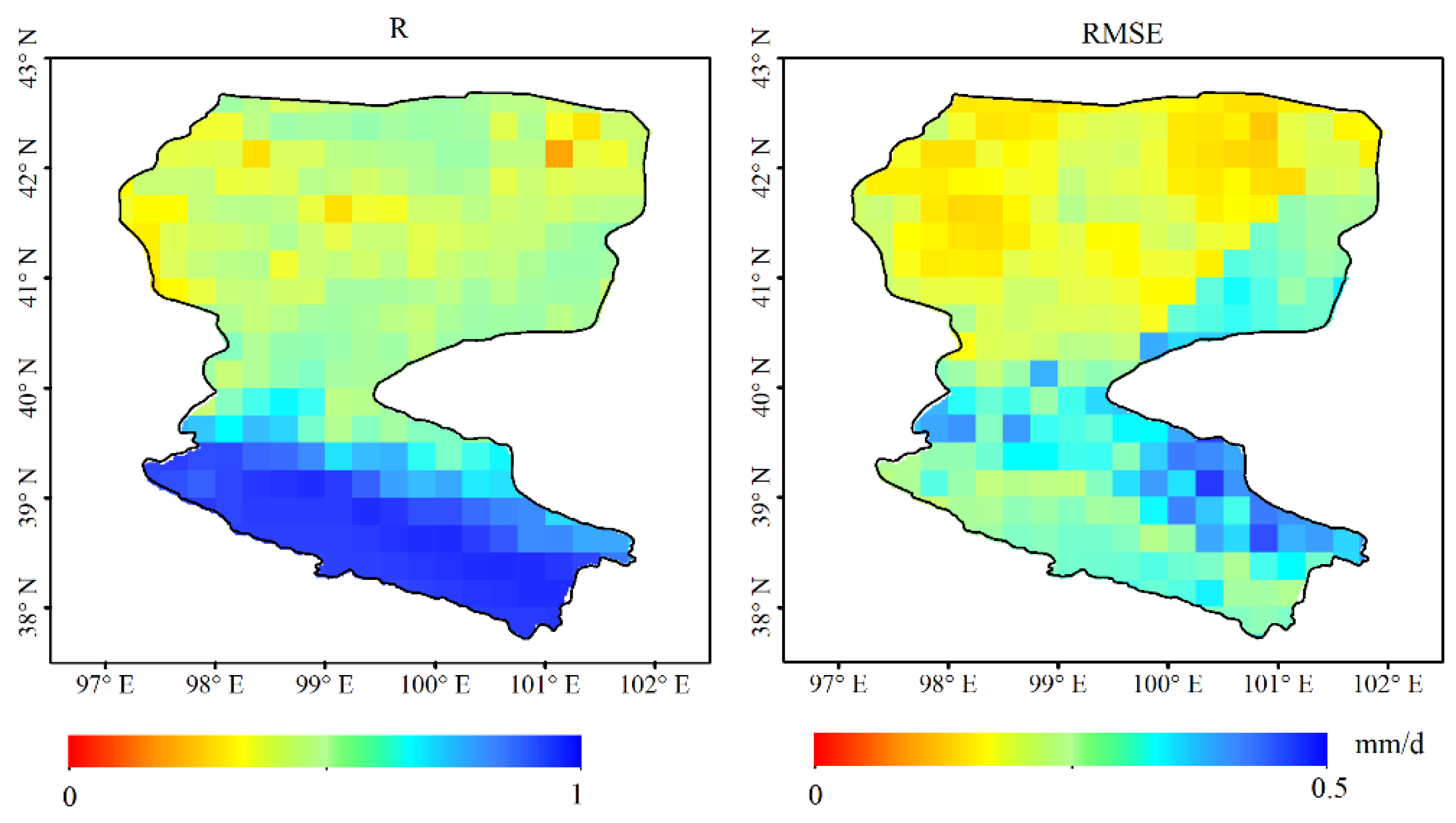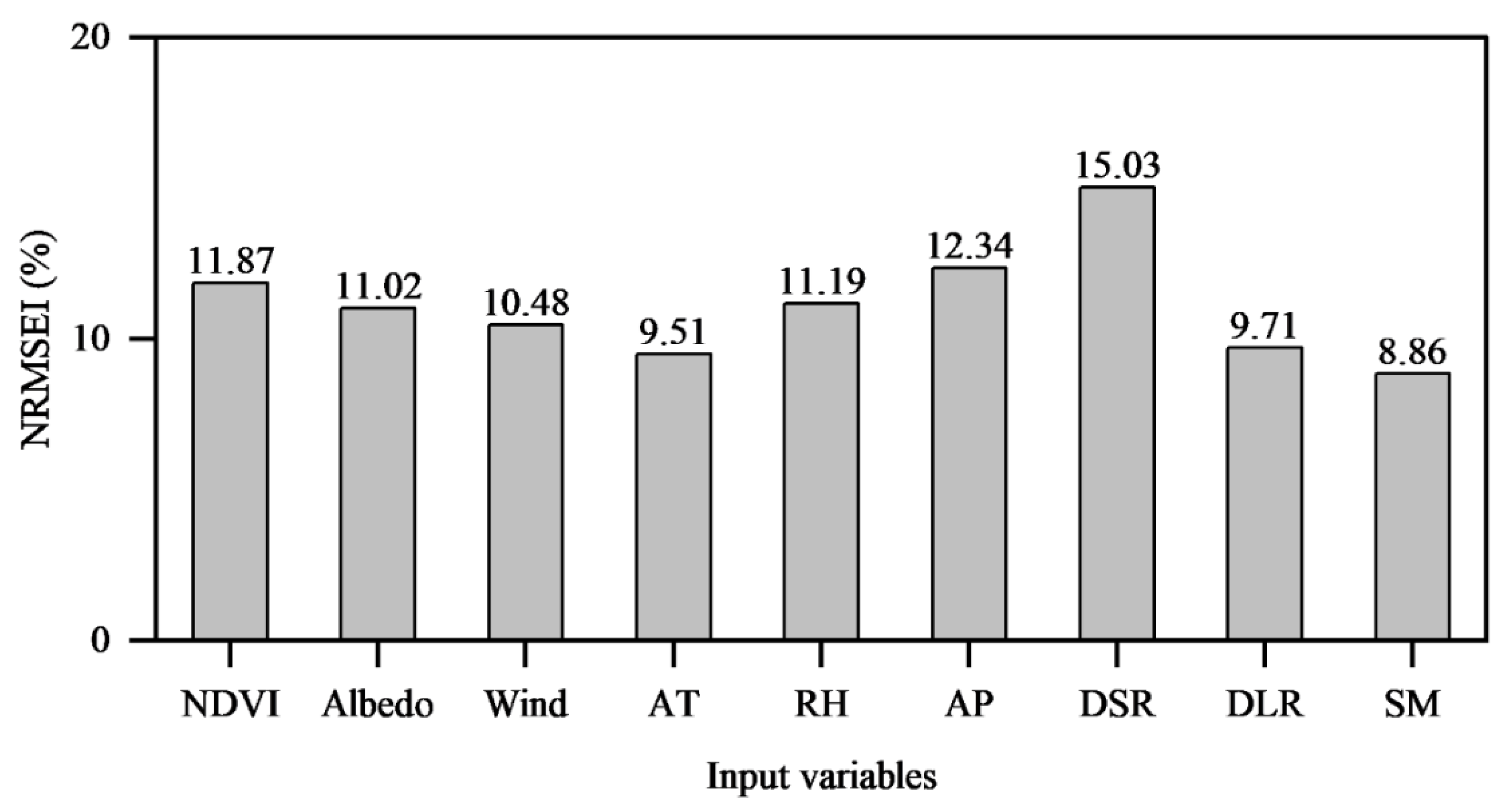Spatially Downscaling a Global Evapotranspiration Product for End User Using a Deep Neural Network: A Case Study with the GLEAM Product
Abstract
:1. Introduction
2. Materials and Methods
2.1. Study Area
2.2. Data Sets
2.2.1. Input Data for DNN
Satellite Data
Meteorological Data
2.2.2. GLEAM ET Product
2.2.3. Ground Data
2.3. Methods
2.3.1. Obtaining High Spatiotemporal Resolution Input Data
2.3.2. Obtaining Low Spatial Resolution Input Data
2.3.3. Training DNN at Low Spatial Resolution
2.3.4. Downscaling the ET to High Spatial Resolution
2.3.5. Performance Metrics
3. Results
3.1. Overall Performance of the Original and Downscaled ET
3.2. Spatial and Temporal Comparison of the Downscaled and Original ET
3.3. Analyzing Importance of Input Variables
4. Discussion
4.1. The Effect of Land Cover
4.2. Advantages and Limitations of This Study
5. Conclusions
- (1)
- The overall R, RMSE, bias and NSE between the downscaled ET and the ground ET are 0.90, 0.87 mm/d, −0.32 mm/d and 0.62, respectively, which are better than the original ET with overall R, RMSE, bias and NSE of 0.85, 1.08 mm/d, −0.55 mm/d and 0.44, respectively.
- (2)
- The downscaled ET is highly consistent with the original ET, especially for the temporal variability. However, quality of the downscaled ET is strongly affected by the original product.
Author Contributions
Funding
Institutional Review Board Statement
Informed Consent Statement
Data Availability Statement
Acknowledgments
Conflicts of Interest
References
- Kim, S.H.; Sicher, R.C.; Bae, H.; Gitz, D.C.; Reddy, V.R.J.G.C.B. Canopy photosynthesis, evapotranspiration, leaf nitrogen, and transcription profiles of maize in response to CO2 enrichment. Glob. Chang. Biol. 2010, 12, 588–600. [Google Scholar] [CrossRef]
- Cui, Y.; Chen, X.; Gao, J.; Yan, B.; Tang, G.; Hong, Y. Global water cycle and remote sensing big data: Overview, challenge, and opportunities. Big Earth Data 2018, 2, 282–297. [Google Scholar] [CrossRef]
- Cui, Y.; Jia, L. Estimation of evapotranspiration of “soil-vegetation” system with a scheme combining a dual-source model and satellite data assimilation. J. Hydrol. 2021, 603, 127145. [Google Scholar] [CrossRef]
- Li, S.; Kang, S.; Zhang, L.; Ortega-Farias, S.; Li, F.; Du, T.; Tong, L.; Wang, S.; Ingman, M.; Guo, W. Measuring and modeling maize evapotranspiration under plastic film-mulching condition. J. Hydrol. 2013, 503, 153–168. [Google Scholar] [CrossRef]
- Mu, Q.; Zhao, M.; Kimball, J.S.; McDowell, N.G.; Running, S.W. A remotely sensed global terrestrial drought severity index. Bull. Am. Meteorol. Soc. 2013, 94, 83–98. [Google Scholar] [CrossRef] [Green Version]
- Cui, Y.; Jia, L.; Fan, W. Estimation of actual evapotranspiration and its components in an irrigated area by integrating the Shuttleworth-Wallace and surface temperature-vegetation index schemes using the particle swarm optimization algorithm. Agric. For. Meteorol. 2021, 307, 108488. [Google Scholar] [CrossRef]
- Wang, K.C.; Dickinson, R.E. A review of global terrestrial evapotranspiration: Observation, modeling, climatology, and climatic variability. Rev. Geophys. 2012, 50, 373. [Google Scholar] [CrossRef]
- Zhang, K.; Kimball, J.S.; Running, S.W. A review of remote sensing based actual evapotranspiration estimation. Wiley Interdiscip. Rev. Water 2016, 3, 834–853. [Google Scholar] [CrossRef]
- Rodell, M.; Houser, P.R.; Jambor, U.; Gottschalck, J.; Mitchell, K.; Meng, C.J.; Arsenault, K.; Cosgrove, B.; Radakovich, J.; Bosilovich, M.; et al. The global land data assimilation system. Bull. Am. Meteorol. Soc. 2004, 85, 381–394. [Google Scholar] [CrossRef] [Green Version]
- Martens, B.; Miralles, D.G.; Lievens, H.; van der Schalie, R.; de Jeu, R.A.M.; Fernández-Prieto, D.; Beck, H.E.; Dorigo, W.A.; Verhoest, N.E.C. GLEAM v3: Satellite-based land evaporation and root-zone soil moisture. Geosci. Model Dev. 2017, 10, 1903–1925. [Google Scholar] [CrossRef] [Green Version]
- Martens, B.; Miralles, D.; Lievens, H.; Fernández-Prieto, D.; Verhoest, N.E.C. Improving terrestrial evaporation estimates over continental Australia through assimilation of SMOS soil moisture. Int. J. Appl. Earth Obs. Geoinf. 2016, 48, 146–162. [Google Scholar] [CrossRef]
- Mu, Q.Z.; Zhao, M.S.; Running, S.W. Improvements to a MODIS global terrestrial evapotranspiration algorithm. Remote Sens. Environ. 2011, 115, 1781–1800. [Google Scholar] [CrossRef]
- Cui, Y.; Chen, X.; Xiong, W.; He, L.; Lv, F.; Fan, W.; Luo, Z.; Hong, Y. A Soil Moisture Spatial and Temporal Resolution Improving Algorithm Based on Multi-Source Remote Sensing Data and GRNN Model. Remote Sens. 2020, 12, 455. [Google Scholar] [CrossRef] [Green Version]
- Zhao, W.; Sánchez, N.; Lu, H.; Li, A. A spatial downscaling approach for the SMAP passive surface soil moisture product using random forest regression. J. Hydrol. 2018, 563, 1009–1024. [Google Scholar] [CrossRef]
- Nanjundiah, S. Downscaling of precipitation for climate change scenarios: A support vector machine approach. J. Hydrol. 2006, 330, 621–640. [Google Scholar]
- Cui, Y.; Song, L.; Fan, W. Generation of spatio-temporally continuous evapotranspiration and its components by coupling a two-source energy balance model and a deep neural network over the Heihe River Basin. J. Hydrol. 2021, 597, 126176. [Google Scholar] [CrossRef]
- Tran Anh, D.; Van, S.P.; Dang, T.D.; Hoang, L.P. Downscaling rainfall using deep learning long short-term memory and feedforward neural network. Int. J. Climatol. 2019, 39, 4170–4188. [Google Scholar] [CrossRef]
- Xu, W.; Zhang, Z.; Long, Z.; Qin, Q. Downscaling SMAP Soil Moisture Products with Convolutional Neural Network. IEEE J. Sel. Top. Appl. Earth Obs. Remote Sens. 2021, 14, 4051–4062. [Google Scholar] [CrossRef]
- Li, X.; Li, X.W.; Li, Z.Y.; Ma, M.G.; Wang, J.; Xiao, Q.; Liu, Q.; Che, T.; Chen, E.X.; Yan, G.J.; et al. Watershed Allied Telemetry Experimental Research. J. Geophys. Res. Atmos. 2009, 114, 11590. [Google Scholar] [CrossRef] [Green Version]
- Hu, G.; Jia, L. Monitoring of Evapotranspiration in a Semi-Arid Inland River Basin by Combining Microwave and Optical Remote Sensing Observations. Remote Sens. 2015, 7, 3056–3087. [Google Scholar] [CrossRef] [Green Version]
- Liu, N.; Liu, Q.; Wang, L.; Wen, J. A temporal filtering algorithm to reconstruct daily albedo series based on GLASS albedo product. In Proceedings of the Geoscience and Remote Sensing Symposium (IGARSS), Vancouver, BC, Canada, 24–29 July 2011; pp. 4277–4280. [Google Scholar]
- Liu, Y.Y.; Parinussa, R.M.; Dorigo, W.A.; de Jeu, R.A.M.; Wagner, W.; van Dijk, A.I.J.M.; McCabe, M.F.; Evans, J.P. Developing an improved soil moisture dataset by blending passive and active microwave satellite-based retrievals. Hydrol. Earth Syst. Sci. 2011, 15, 425. [Google Scholar] [CrossRef] [Green Version]
- He, J.; Yang, K.; Tang, W.; Lu, H.; Qin, J.; Chen, Y.; Li, X. The first high-resolution meteorological forcing dataset for land process studies over China. Sci. Data 2020, 7, 25. [Google Scholar] [CrossRef] [PubMed] [Green Version]
- Miralles, D.G.; Holmes, T.R.H.; De Jeu, R.A.M.; Gash, J.H.; Meesters, A.G.C.A.; Dolman, A.J. Global land-surface evaporation estimated from satellite-based observations. Hydrol. Earth Syst. Sci. 2011, 15, 453–469. [Google Scholar] [CrossRef] [Green Version]
- Liu, S.; Li, X.; Xu, Z.; Che, T.; Xiao, Q.; Ma, M.; Liu, Q.; Jin, R.; Guo, J.; Wang, L.; et al. The Heihe Integrated Observatory Network: A Basin-Scale Land Surface Processes Observatory in China. Vadose Zone J. 2018, 17, 180072. [Google Scholar] [CrossRef]
- Jia, L.; Shang, H.; Hu, G.; Menenti, M. Phenological response of vegetation to upstream river flow in the Heihe Rive basin by time series analysis of MODIS data. Hydrol. Earth Syst. Sci. 2011, 15, 1047–1064. [Google Scholar] [CrossRef] [Green Version]
- Menenti, M.; Azzali, S.; Verhoef, W.; Vanswol, R. Mapping Agroecological Zones And Time-Lag In Vegetation Growth by Means Of Fourier-Analysis Of Time-Series Of Ndvi Images. Adv. Space Res. 1993, 13, 233–237. [Google Scholar] [CrossRef]
- Jia, L.; Xi, G.; Liu, S.; Huang, C.; Yan, Y.; Liu, G. Regional estimation of daily to annual regional evapotranspiration with MODIS data in the Yellow River Delta wetland. Hydrol. Earth Syst. Sci. 2009, 13, 1775–1787. [Google Scholar] [CrossRef] [Green Version]
- Cui, Y.; Long, D.; Hong, Y.; Zeng, C.; Zhou, J.; Han, Z.; Liu, R.; Wan, W. Validation and reconstruction of FY-3B/MWRI soil moisture using an artificial neural network based on reconstructed MODIS optical products over the Tibetan Plateau. J. Hydrol. 2016, 543, 13. [Google Scholar] [CrossRef]
- Tao, Y.; Gao, X.; Hsu, K.; Sorooshian, S.; Ihler, A. A deep neural network modeling framework to reduce bias in satellite precipitation products. J. Hydrometeorol. 2016, 17, 931–945. [Google Scholar] [CrossRef]
- Fang, K.; Shen, C.; Kifer, D.; Xiao, Y.J.G.R.L. Prolongation of SMAP to Spatio-temporally Seamless Coverage of Continental US Using a Deep Learning Neural Network. Geophys. Res. Lett. 2017, 44, 11–30. [Google Scholar] [CrossRef] [Green Version]
- Cui, G.X.; Leng, H.J.; Wang, K.; Wang, J.W.; Zhu, S.N.; Jia, J.; Chen, X.; Zhang, W.G.; Qin, L.H.; Bai, W.P. Effects of Remifemin Treatment on Bone Integrity and Remodeling in Rats with Ovariectomy-Induced Osteoporosis. PLoS ONE 2013, 8, e82815. [Google Scholar] [CrossRef] [PubMed]
- Monteith, J.L. Evaporation and environment. Symp. Soc. Exp. Biol. 1965, 19, 205–234. [Google Scholar] [PubMed]







| Type | Variable | Data Sets | Spatiotemporal Resolution |
|---|---|---|---|
| Input data | NDVI | MOD13A2 | 1 km/8 d |
| Albedo | GLASS | 1 km/8 d | |
| SM | ESA ECV | 0.25°/daily | |
| WS | DAMCTM | 0.1°/3 h | |
| AT | DAMCTM | 0.1°/3 h | |
| RH | DAMCTM | 0.1°/3 h | |
| AP | DAMCTM | 0.1°/3 h | |
| DSR | DAMCTM | 0.1°/3 h | |
| DLR | DAMCTM | 0.1°/3 h | |
| GLEAM | ET | V03.3a | 0.25°/daily |
| Ground-data | ET | -- | Point/30 min |
| Stations | Original ET | Downscaled ET | ||||||
|---|---|---|---|---|---|---|---|---|
| R | RMSE | Bias | NSE | R | RMSE | Bias | NSE | |
| AR | 0.91 | 0.85 | −0.52 | 0.63 | 0.95 | 0.74 | −0.43 | 0.71 |
| GT | 0.84 | 0.54 | 0.03 | 0.70 | 0.85 | 0.64 | 0.28 | 0.59 |
| YK | 0.78 | 1.83 | −1.16 | −0.01 | 0.92 | 1.22 | −0.79 | 0.56 |
| Mean | 0.85 | 1.08 | −0.55 | 0.44 | 0.90 | 0.87 | −0.32 | 0.62 |
| Stations | This Study | MODIS ET | ||||||
|---|---|---|---|---|---|---|---|---|
| R | RMSE | Bias | NSE | R | RMSE | Bias | NSE | |
| AR | 0.96 | 0.67 | −0.40 | 0.73 | 0.85 | 0.67 | −0.80 | 0.67 |
| GT | 0.93 | 0.45 | 0.27 | 0.74 | 0.85 | 0.52 | 0.09 | 0.68 |
| YK | 0.94 | 1.17 | −0.80 | 0.54 | 0.83 | 1.27 | −0.80 | 0.45 |
| Mean | 0.94 | 0.76 | −0.31 | 0.67 | 0.84 | 0.82 | −0.50 | 0.60 |
Publisher’s Note: MDPI stays neutral with regard to jurisdictional claims in published maps and institutional affiliations. |
© 2022 by the authors. Licensee MDPI, Basel, Switzerland. This article is an open access article distributed under the terms and conditions of the Creative Commons Attribution (CC BY) license (https://creativecommons.org/licenses/by/4.0/).
Share and Cite
Long, X.; Cui, Y. Spatially Downscaling a Global Evapotranspiration Product for End User Using a Deep Neural Network: A Case Study with the GLEAM Product. Remote Sens. 2022, 14, 658. https://doi.org/10.3390/rs14030658
Long X, Cui Y. Spatially Downscaling a Global Evapotranspiration Product for End User Using a Deep Neural Network: A Case Study with the GLEAM Product. Remote Sensing. 2022; 14(3):658. https://doi.org/10.3390/rs14030658
Chicago/Turabian StyleLong, Xunjian, and Yaokui Cui. 2022. "Spatially Downscaling a Global Evapotranspiration Product for End User Using a Deep Neural Network: A Case Study with the GLEAM Product" Remote Sensing 14, no. 3: 658. https://doi.org/10.3390/rs14030658
APA StyleLong, X., & Cui, Y. (2022). Spatially Downscaling a Global Evapotranspiration Product for End User Using a Deep Neural Network: A Case Study with the GLEAM Product. Remote Sensing, 14(3), 658. https://doi.org/10.3390/rs14030658






